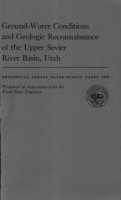Ground-water conditions and geologic reconnaissance of the Upper Sevier River basin, Utah
Links
- Document: Report (pdf)
- Plates:
- Plate 1 (pdf) Reconnaissance geologic map and sections of the Upper Sevier River Basin, Utah
- Plate 2 (pdf) Map showing hydrologic data and phreatophyte areas in the Upper Sevier River Basin, Utah
- Plate 3 (pdf) Graphs of water levels in selected wells and selected analyses of ground and surface water in the Upper Sevier River Basin, Utah
- Download citation as: RIS | Dublin Core
Abstract
The upper Sevier River basin is in south-central Utah and includes an area of about 2,400 .square miles of high plateaus and valleys. It comprises the entire Sevier River drainage basin above Kingston, including the East Fork Sevier River and its tributaries. The basin was investigated to determine general ground-water conditions, the interrelation of ground water and surface water, the effects of increasing the pumping of ground water, and the amount of ground water in storage.
The basin includes four main valleys - Panguitch Valley, Circle Valley, East Fork Valley, and Grass Valley - which are drained by the Sevier River, the East Fork Sevier River, and Otter Creek. The plateaus surrounding the valleys consist of sedimentary and igneous rocks that range in age from Triassic to Quaternary. The valley fill, which is predominantly alluvial gravel, sand, silt, and clay, has a maximum thickness of more than 800 feet.
The four main valleys constitute separate ground-water basins. East Fork Valley basin is divided into Emery Valley, Johns Valley, and Antimony subbasins, and Grass Valley basin is divided into Koosharem and Angle subbasins. Ground water occurs under both artesian and water-table conditions in all the basins and subbasins except Johns Valley, Emery Valley, and Angle subbasins, where water is only under water-table conditions. The water is under artesian pressure in beds of gravel and sand confined by overlying beds of silt and clay in the downstream parts of Panguitch Valley basin, Circle Valley basin, and Antimony subbasin, and in most of Koosharem subbasin. Along the sides and upstream ends of these basins, water is usually under water-table conditions.
About 1 million acre-feet of ground water that is readily available to wells is stored in the gravel and sand of the upper 200 feet of saturated valley fill. About 570,000 acre-feet is stored in Panguitch Valley basin, about 210,000 in Circle Valley basin, about 6,000 in Emery Valley subbasin, about 90,000 in Johns Valley subbasin, about 36,000 in Antimony subbasin, about 90,000 in Koosharem subbasin, and about 60,000 in Angle subbasin. Additional water, although it is not readily available to wells, is stored in beds of silt and clay. Some ground water also is available in the bedrock underlying and surrounding the basins, although the bedrock formations generally are poor aquifers.
The principal source of recharge to the valley fill in the upper Sevier River basin is infiltration from streams, canals, and irrigated fields. Some ground water also miles into the valley till from the bedrock surrounding the basins.
The basin contains about 300 wells, most of which are less than 4 inches in diameter, are less than 250 feet deep, and are used for domestic purposes and stock watering. More than half the wells are flowing wells in Koosharem subbasin.
Approximately 82,000 acre-feet of ground water was discharged in 1962 from the valley till. Springs discharged about 33,000 acre-feet, wells about 3,000, and drains about 3,000; and evapotranspiration from phreatophyte areas about 43,000 acre-feet. Springs in bedrock discharged an additional 75,000 acre-feet. Most of the water discharged by springs, wells, and drains was used for irrigation.
The ground water in the basin generally is of good chemical quality. The water is excellent for irrigation and stock but is not as desirable for most domestic and industrial uses because of its hardness. The dissolved-solids content of the ground water generally increases slightly from the upstream end of the individual ground-water basins to. the downstream end owing mostly to repeated use of the water for irrigation.
Surface water and ground water in the upper Sevier River basin are inter- connected, and the base flows of streams are affected by changes in ground- water levels. Increased pumping of ground water would result in (1) an increase in the recharge to the aquifers from surface-water sources or (2) a decrease in the discharge from streams, springs, flowing wells, and areas of phreatophytes or (3) a combination of these.
About 43,000 acre-feet of ground water is now discharged annually by evapotranspiration from phreatophyte areas, and perhaps one-third of this loss, or about 14,000 acre-feet, could be salvaged by eliminating wet areas and phreatophytes. The areas where water could be salvaged are at the downstream ends of Panguitch Valley basin, Circle Valley basin, and Antimony subbasin. Most of the 14,000 acre-feet 'of water could be pumped from large-diameter wells or developed by properly designed drains without greatly affecting stream- flow and with only moderate effect on 'spring discharge. If the wells were properly located, the pumping would lower water levels and dry up wet areas where phreatophytes grow. Conjunctive use of ground water and surface water would facilitate the more efficient use of all water resources in the basin
| Publication type | Report |
|---|---|
| Publication Subtype | USGS Numbered Series |
| Title | Ground-water conditions and geologic reconnaissance of the Upper Sevier River basin, Utah |
| Series title | Water Supply Paper |
| Series number | 1836 |
| DOI | 10.3133/wsp1836 |
| Year Published | 1967 |
| Language | English |
| Publisher | U.S. Government Printing Office |
| Publisher location | Washington, D.C. |
| Contributing office(s) | Utah Water Science Center |
| Description | Report: vi, 91 p.; 3 Plates: 35.00 in. x 49.87 in. or smaller |
| Country | United States |
| State | Utah |
| Other Geospatial | Upper Sevier River Basin |


